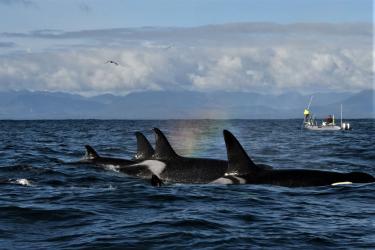Bart Merrick has worked with NOAA for more than 10 years. He is the Education Coordinator for NOAA Chesapeake Bay Office’s Environmental Science Training Center in Oxford, Maryland.
Describe a project related to habitat that you are currently working on.
This spring we have been working with Easton Middle School and the Town of Easton on a project that connects the students to a stream restoration project designed to improve habitat and water quality in Papermill Branch, a stream that runs right behind the school. Students are involved in monitoring water quality and habitat conditions in the stream before and after the restoration project as well as assisting with design elements and plantings.
What habitat work has been especially successful or inspiring to you?
The work of the science, management, nonprofit, and other communities to put together and get some large-scale oyster restoration work done in the Choptank River. I find this work to be inspiring not only due to the apparent success of the effort, but also the work going on to connect restoration and conservation efforts to the broader community. As an educator, I am very interested in supporting all ages as they make decisions that will ultimately affect the places we live, work, and play. These decisions and the community’s perspectives about the restoration effort will ultimately determine the long-term success of these restoration efforts.
Describe a time when you were surprised by fish and/or habitat.
I have been surprised by the fish and habitat in the Chesapeake many times, whether it is that first jellyfish sting (now just an annoyance) or the incredible beauty of an expansive salt marsh at sunrise. Perhaps one of my greatest surprises came just few weeks ago when my daughter (Luisa) and I were out on a stand-up paddleboard, paddling a creek. It was one of those early summer evenings: beautiful light, calm water, pretty much everything you would want for an evening paddle with a four-year-old. We paddled all the way up to the head of the creek; the water was incredibly clear. When we turned around and started paddling, we found ourselves right in the middle of what seemed to be a huge pack of cownose rays. Both Luisa and I were a bit concerned, but after a few minutes it was just amazing to watch the rays ever so gracefully gliding through the creek. Just awesome.
What person has expanded your understanding or connection to habitat?
Nick Carter used to work for the Maryland Department of Natural Resources at the same lab where I work now, the Cooperative Oxford Lab. He is the epitome of a biologist/naturalist. A few years back I had the incredible opportunity to spend a week kayaking down the chain of islands that runs along the Tangier Sound. The trip was one of those opportunities to truly immerse ourselves in the resource. I remember kayaking alongside Nick at one point during the trip and asking about the role of the tiny crabs (fiddler crabs, I believe) that make all the holes in the banks of the guts we paddled through. Seemed to me that there were so many holes in the bank that at some point it would collapse, making the salt marsh even more vulnerable to sea-level change. Nick and I had a long conversation about the components of this salt marsh system and how they interact to maintain the marsh in the face of what really are some extreme conditions (flooded, dry, exposed), and this conversation set me on a path of recognizing some cool things about the habitats we visit and thinking about how these things fit into a bigger picture and help systems like a salt marsh find equilibrium and maintain themselves. Unless, of course, they are really disturbed systems.



